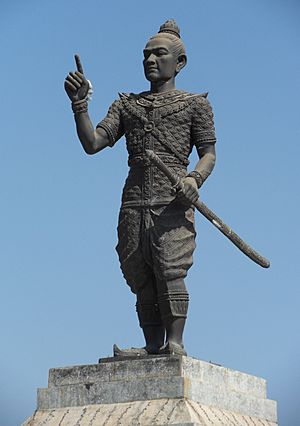Fa Ngum facts for kids
Quick facts for kids Fa Ngumພຣະເຈົ້າຟ້າງຸ້ມມະຫາຣາຊ |
|||||
|---|---|---|---|---|---|
| King of Lan Xang Lao: ພຣະມະຫາກະສັຕຍ໌ ແຫ່ງ ລ້ານຊ້າງ | |||||
 |
|||||
|
|||||
| Reign | 1353–1372 | ||||
| Coronation | 1353 | ||||
| Successor | Samsenethai | ||||
| Born | 1316 Muang Sua, Lan Xang |
||||
| Died | 1393 (aged 77) Muang Nan, Nan |
||||
| Spouse | Queen Keo Kang Ya (Khmer) Queen Keo Lot Fa (Ayutthaya) | ||||
| Issue | Prince Oun Heuan Prince Kham Kong Princess Keo Ketkasi |
||||
|
|||||
| Dynasty | Khun Lo | ||||
| Father | Khun Phi Fa | ||||
| Religion | Therevada Buddhism Animism |
||||
Fa Ngum (born 1316, died 1393) was a very important king in the history of Laos. He is famous for creating the kingdom of Lan Xang in 1353. Lan Xang means "Land of a Million Elephants." This kingdom was a powerful state in Southeast Asia. Fa Ngum was born in a place called Muang Sua, which is now Luang Prabang.
Contents
Fa Ngum's Early Life
Fa Ngum was born in 1316 in Muang Sua. His father was Phi Fa. Fa Ngum was raised by a wise religious teacher named Maha Pasaman Chao.
When Fa Ngum was young, he and his father were sent away from their home. This is called being exiled. One story says his father had a problem with his grandfather's wife. Another story says Fa Ngum was born with 33 teeth. This was seen as a strange sign that could threaten the kingdom. So, he was sent to the Khmer Empire (modern-day Cambodia).
While in the Khmer Empire, Fa Ngum married a princess named Kaeo Kang Ya. She was from the Khmer royal family.
Building the Kingdom of Lan Xang
With help from the Khmer Empire, Fa Ngum returned to his homeland. He came with a large army of 10,000 soldiers. His goal was to unite the different small areas and create one big kingdom.
In 1353, Fa Ngum successfully founded the kingdom of Lan Xang. The full name was Lan Xang Hôm Khao. This means "Land of a Million Elephants and a White Parasol."
- The "million elephants" showed the kingdom's military strength. Elephants were used in battles.
- The "white parasol" was a symbol of royalty and a Buddhist king.
Fa Ngum made Theravada Buddhism the main religion of his new kingdom. His teacher, Maha Pasaman, brought important Buddhist texts and a sacred Buddha image called the Phra Bang. This image became a spiritual protector for Lan Xang. Fa Ngum chose Xiang Dong Xiang Thong (later called Luang Prabang) as his capital city.
Conquests and Expansion
Fa Ngum was a strong military leader. He expanded his kingdom by conquering many areas.
- He took control of parts of modern-day Vietnam.
- He also conquered areas in what is now Isan, Thailand.
- Between 1352 and 1354, he captured important cities like Muang Sing, Chiang Hung, and Chiang Mai.
- In 1353, he conquered Vientiane and Xiangkhouang Province.
- He fought and won a battle against his uncle near Xiang Dong Xiang Thong. This made him the clear ruler of the land.
Later Years and Legacy
Fa Ngum ruled Lan Xang for many years. However, in 1373, the nobles and important people in his court decided to send him away. This was another exile for Fa Ngum. He died in 1393.
After Fa Ngum, his son, Oun Huan, became king. Oun Huan is better known as Samsenethai. He was only about 18 years old when he became king. The name Samsenethai means "300,000 Tai people." This name came from a census that counted 300,000 Tai people living in Lan Xang. Samsenethai created a new system for governing the kingdom.
Fa Ngum is remembered as the founder of Lan Xang. He brought different regions together and established a powerful kingdom that lasted for centuries. He also helped spread Theravada Buddhism in the region.
Fa Ngum's Family
- Father: Samdach Brhat-Anya Phya Vath, King of Rajadharani Sri Sudhana
- Wives and Children:
- Queen Keo Kang Ya (from the Khmer Empire)
- Prince Oun Huan (who became King of Lan Xang)
- Prince Kham Kong
- Princess Keo Ketkasi
- Queen Keo Lot Fa (from the Ayutthaya Kingdom)
- Queen Keo Kang Ya (from the Khmer Empire)

